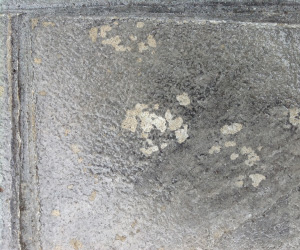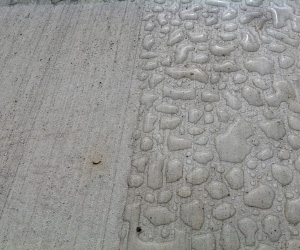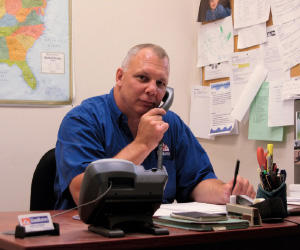 |
 Seal the Deal
Seal the Deal
ChemMasters Newsletter: Vol 4 Issue 3
7 Coatings for Exterior Decorative Concrete
By John Fauth – Vice President, Marketing & Business Development – ChemMasters, Inc.
Originally Published by “Concrete Contractor” Magazine and “ForConstructionPros.com”, June/July 2016 Edition

Golf and concrete can both be made decorative.
I am a golf enthusiast, which seems completely unrelated to the coatings industry. But if we take a closer you’ll see they actually have quite a lot in common.
To begin, every golf course is unique and so is every concrete substrate. Different designs, different finishes, different hazards… you can’t expect to treat them all the same. Even when playing the same course or coating the same substrate, environmental conditions impact our expectations and outcomes. Humidity and precipitation, air movement, temperature, whether the substrate/turf is wet or dry… these are variables that change day by day, or even hour by hour.
Those changing conditions dictate that we employ different strategies and tools that are suitable for the environment. In golf we’re focused upon the environmental conditions during our round, but when it comes to concrete coatings there is the added complication of choosing coatings that are also compatible with the environmental conditions encountered throughout its service life.
When golfing, I make choices about techniques that optimize my chances for a successful shot… a higher or lower ball flight; adjusting my alignment; cutting distance off a dogleg. Those choices might be analogous to coating applications that avoid high winds or temperatures; conditioning my product to an acceptable temperature; waiting until the temperature is sufficiently above the dew point. These are all accommodations we make because we can’t control the environment.
But there is something we CAN control. There are 14 clubs in my golf bag that I can choose from to optimize my results based upon the conditions of the course and the environment. If I dropped a ball in an identical spot on three consecutive days, it’s quite possible I might choose three different clubs based upon those changing conditions. And although every golfer has a favorite club, they will vary their club selection based upon the course and environmental conditions. But all too often, contractors will choose their “favorite” product day after day, substrate after substrate, regardless of the service or environmental conditions. Despite the many coating choices available to them.
No golfer can play consistently well using only one club, and no contractor can consistently produce acceptable outcomes using only one coating. Particularly on exterior decorative concrete where environmental conditions vary the most and aesthetics are essential. Let’s take a look at some of the available coating chemistries along with their relationship to environmental conditions and exterior decorative concrete as a means of understanding all the “clubs” in a contractor’s bag.
Water-Based Acrylics
Water-based acrylics form harder, more chemically resistant coatings, are more tolerant of higher temperatures, and not prone to bubbling as compared to their solvent-based offsets. They are good choices for decorative concrete that may be exposed to various automobile fluids or foods and beverages that may cause staining, or for use on hot, windy days.

ChemMasters water-based acrylics are easier to use in windy, hot conditions.
Those qualities must be weight against their reduced gloss levels and color development integral colors and stains, and inability to easily wet out antiquing releases used on stamped concrete. Some clients will appreciate those characteristics and others won’t. Beauty is in the eye of the beholder.
Their solvent resistance means they are not easily recoatable or “repairable” and traditional repair techniques using xylene are not effective. This chemistry is also impacted by high humidity and/or low temperatures, which delay evaporation and coalescence, which can result in a lack of film formation and complete coating failure if coalescing solvents evaporate before the water.
Solvent-Based Acrylics
The solvent component in these products help produce unique aesthetic qualities often preferred on decorative concrete. They wet out antiquing release agents, deepen and enrich integral colors and/or stains, and can produce satin/matte to very high gloss finishes. Those are qualities that will appeal to many decorative concrete clients, but not all of them.

ChemMasters solvent-based sealers will enhance color development and gloss.
These are lacquer systems that will re-solvate when exposed to solvents. That’s a desirable quality when re-applying sealer or repairing damaged sealer, but can be a problem if installed in an environment prone to frequent solvent exposures.
Solvent-based acrylic products, particularly those that use exempt solvents to meet state VOC limitations, can be tricky to use in hot and windy conditions. Exempt solvents evaporate rapidly which can increase the likelihood of bubble formation (immediately following application, or overnight) and excess film thickness that leads to “whitening” or delamination.
Non-Yellowing Acrylics
The term “non-yellowing” is based upon ASTM C1315 references to the Gardner Scale as a means of rating the color stability of resins that undergo 336 hours of accelerated UV exposure. Following the test, products are categorized as Class A (non-yellowing), Class B (moderate yellowing) or Class C (unrestricted yellowing).
Unfortunately, it’s common for manufacturers to use styrene-acrylic blends when formulating acrylic cures and sealers. The styrene component lowers costs and improves curing efficiency, but also yellows/browns with UV exposure. Added UV inhibitors act as sponges to absorb UV and delay yellowing. But just like sponges that absorb water, these UV inhibitors can only absorb so much before they become ineffective and the styrene resin begins to yellow/brown.
If they make it through 336 hours of UV exposure, they’re Class A non-yellowing and whatever happens at 337 hours or beyond does not change that designation. This is a real deficiency in the ASTM C1315 specification as it relates to decorative concrete, where color shift is unacceptable and sealers are applied more frequently.
As a result, it’s advisable to use a fully non-yellowing resin (pure acrylic, siliconized-acrylic or methacrylate) rather than a resin that’s formulated to “beat the test” (styrene-acrylic blend).
Polyaspartics & Polyureas
These chemistries are very durable and UV stable with excellent aesthetic qualities. Like solvent-based acrylics they will wet out antiquing release agents use on stamped concrete, deepen and enrich the appearance of integrally colored or stained concrete, and can produce matte to high gloss finishes.
Regrettably they are not easily recoatable on decorative concrete, and require an abraded, roughened surface prior to reapplication. This isn’t always possible or desirable on decorative concrete, particularly profiled versions such as stamped or exposed aggregate.

Sealers that are not sufficiently breathable can delaminate from the concrete surface.
They’re also not very “breathable” chemistries which is a real problem on exterior concrete that is characterized by plenty of subsurface moisture transmission that needs to pass through the coating. Although these products bond tenaciously to the concrete and are not likely to “whiten” or delaminate, they can trap moisture that will place stresses on the substrate surface. If the surface is weak, or exposed to freeze/thaw, this can result in spalling or delamination of the substrate itself.
All things considered, polyaspartics and polyureas may be good choices for use on vertical decorative concrete in exterior applications and less so for horizontal.
Epoxies
Epoxies are hard, durable and very attractive coatings. When used in the proper environment they look great and perform well for a long time. But this chemistry is characterized by the same recoatability and breathability issues as polyaspartics and polyureas. More importantly, epoxies are not typically UV stable and are likely to yellow/brown when used on exterior decorative concrete. Consequently, epoxies are good choices as primers for pigmented top coatings on exterior concrete, rather than the top coat itself.
Urethanes
Urethanes are very UV stable, durable, aesthetically attractive and available in a wide variety of pigments. Their deficiencies include an intolerance for the high alkalinity of concrete and need for a primer such as epoxy.
Although urethanes are very breathable, the epoxy primer is not. This system will also require abrasion prior to recoating.
Epoxy/urethane systems work well on vertical decorative concrete in exterior applications, but would not often be a good choice for horizontal use.
Silicones/Silanes/Siloxanes/Silicates

Penetrating chemistries are both water repellent and breathable, but do not enhance color development, gloss or aesthetics.

ChemMasters’ Technical Service Manager John Kirk answers product, application and service questions at 1-800-486-7866.
Products using these chemistries can have marvelous protective characteristics and breathability, making them ideal for use on concrete exposed to freeze/thaw cycling and deicing chemicals. However, penetrating chemistries do not possess the aesthetic qualities often desired for decorative concrete. They will not deepen/enrich integrally colored or stained concrete, do not produce a gloss, and provide no stain resistance. As a result, they are better suited for use on broom or trowel finished concrete in freeze/thaw environments.
Educate Yourself
Always consult the manufacturer’s technical data sheets to be certain the product you’ve chosen is recommended for use in your intended application and service environment. Pay particular attention to any limitations or cautions. Don’t hesitate to consult directly with the manufacturer’s technical service department if you have any questions or concerns.
These are a few of the chemistries in common use today. Some or all of them should be in your “bag”, available to use as the situation dictates. Each is a great choice when used in a compatible application and service environment. Let those conditions guide you to the right choice.
Silencure, Polyseal, Traz, Aquanil, Spall Guard, Chemisil, EZ Strip Cure, SafeSeal, Spray Film, DuraShield SRT, Slip Stop and Exposee are trademarks of ChemMasters, Inc. ChemMasters and Safe-Cure are registered trademarks of ChemMasters, Inc.
300 Edwards Street, Madison, Ohio 44057
Phone 440.428.2105 - 800.486.7866
Fax 440.428.7091
Silencure, Polyseal, Traz, Aquanil, Spall Guard, Chemisil, EZ Strip Cure, SafeSeal, Spray Film, DuraShield SRT, Slip Stop and Exposee are trademarks of ChemMasters, Inc. ChemMasters and Safe-Cure are registered trademarks of ChemMasters, Inc.

Phone 440.428.2105 - 800.486.7866
Fax 440.428.7091
ERISA Documents for Welfare Benefit Plan
